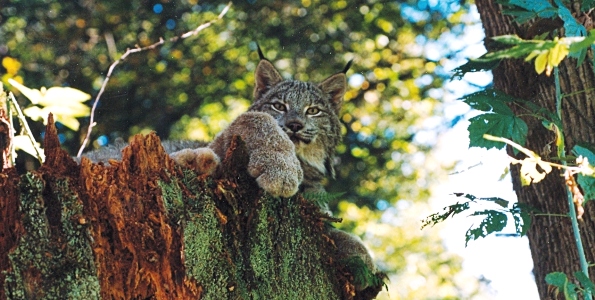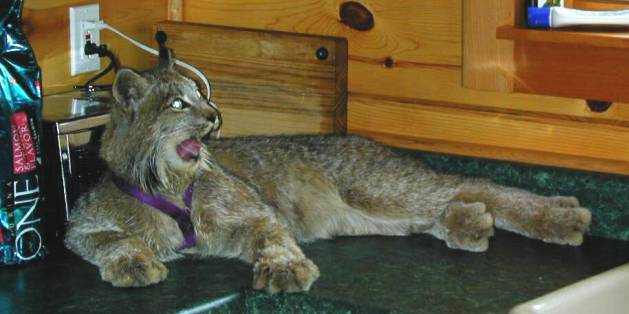
What wild land is there left for the animals?
By Brittany Shute , Spring 2007

When one thinks about humans owning exotic pets, such as bears, lion, tigers, leopards, lynx, wolves, raccoons, etc., the inevitable questions come to mind. The brain forms these sentences with an imaginary pencil:
|
|
Many, perhaps most, humans are against the private
hobby of owning such companion exotic animals. The ban of them in states
and provinces is influenced by animal-rights groups such as People for the
Ethical Treatment of Animals (PETA), United Stated Humane Society (HSUS),
Farm Sanctuary, Green Peace, Animal Protection Institution (API), and Animal
Liberation Front (ALF). While it must be made clear that not everyone should
own something that requires as much responsibility, for example, as bears
and lions do, these groups claim that all owners are unqualified.
They feel all owners are untrustworthy simply because others have not seen
the responsibility responsibly. PETA as well as others claim that millions
of animals are seized from their mothers in the wild jungles, then bottle
fed to depend on fore their so-called “breeder” and then be sold at
auctions. However, this is an occurrence that almost never happens anymore
with wild animals. In fact, for generations they have been bred out of the
wild, so much in fact that some animals, like raccoons, foxes and skunks can
come in colors never imaginable in the wild such as brown, albino, blond,
cappuccino, honey, blue, marble, gold, and lavender. And the good breeders
who care about in which hands their beloveds end up selling them to owners
whom know what they are getting into, and simply don’t want them for only
the uniqueness of the animal. Most animals born in the wild live less than
three years! An exotic in captivity can live about twenty years, depending
on the kind, if well taken care of. Responsible owners do care strongly
about what happens to their animals in their lifetime, and provide as anyone
would for domestic Fido or Fluffy.
“But these are dangerous animals!” one might use to protest. Well,
put it this way; all animals can hurt a person, whether lethally or not.
Some exotics, like servals (small cats) and foxes have never been known to
kill a person, while others like, bears, big cats, and crocodilians can. It
can never be forgotten that these are always wild animals, no matter how
loving and tame, and the decision to bring one into ones life should never
be a decision made lightly. However, once upon a time dogs were wolves, and
cats had the disposition of their African wild relatives. It is often said
that it takes thousands of years to domesticate animal, but hamster have
only been in the pet trade since the 1930’s, yet are currently considered
domestic. Cheetahs and elephants have been tamed by man for thousands of
years but are still considered exotic. Are exotic or wild animals
exceptionally dangerous?
In the past ten years, on average 3 people a year have
been killed by all captive exotics (big cats, reptiles, elephants, bears...). It
generally does happen to an owner unless something unbelievably stupid
happens, like parents allowing their kids to go into a cage with a big cat
or bear. Compare these factors with what is done with domestic animal. Now,
the common “domestic” dog kills at least twenty people a year. And it is
worth mentioning that they send millions of us humans to the hospital every
year due to serious wounds! Horses kill over hundred a year, either by
trampling or bucking off their riders. And still, it is humans who cause the
most trouble. The most often, we start wars based by the belief of religion
or culture. It is truly we who and our tame animals that are the hunter, not
the hunted.
In conclusion, I hope that the facts about exotic pets have made an impact
in opinions. Any beast can be dangerous to mankind, but it is true that most
often it is horses, dogs, and humans who cause more damage, than lions and
tigers and bears (oh my!).
We humans are fighting a war against nature, and refuse to believe that we are all a part of Mother Earth. Non-domestic creatures have a chance to survive thanks to a patient, knowledgeable, experienced, and loving owner. Perhaps, if we encourage contact between man and exotic animals, there may be more motivation to protect our threatened planet. Humans will realize that they can live side by side with God’s creations.

Brittany Shute has 1 dog, 1 cat (domestic) and 1 corn snake, though she works constantly with tigers, lions, leopards, jaguars, foxes, raccoons, snakes, alligators, exotic fish, raptors, wolves, cougars, and others. She find joy animals, bikes, books (especially Harry Potter), The Beatles, swimming, painting, and tae-kwon do (at the current timing, Brittany's a green belt.) She have a distaste for animals right groups, people without a sense of humor, mathematics, and waking up early. The places Brittany want to see someday would include Sydney Australia, Kenya, India, and Israel. If she could meet three people, dead or alive, she would choose: Steve Irwin, John Lennon, and JK Rowling. She can be reached at btshute@rogers.com
Photos Copyright 2007 © Zuzana Kukol & REXANO,
All Rights Reserved
www.REXANO.org